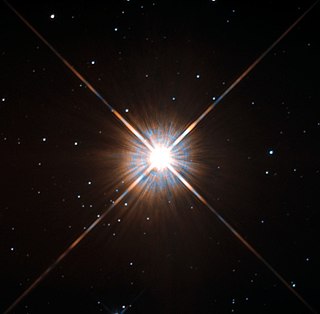Michael Ely is the writer of the trilogy of books surrounding the events in the computer game Sid Meier's Alpha Centauri .
Michael Ely is the writer of the trilogy of books surrounding the events in the computer game Sid Meier's Alpha Centauri .

Alpha Centauri is a gravitationally bound system of the closest stars and exoplanets to our Solar System at 4.37 light-years from the Sun. The name is Latinized from α Centauri, and abbreviated Alpha Cen or α Cen. It is a triple star system, consisting of the three stars: α Centauri A, α Centauri B, and the closest star α Centauri C.

Sid Meier's Alpha Centauri is a 4X video game, considered a spiritual sequel to the Civilization series. Set in a science fiction depiction of the 22nd century, the game begins as seven competing ideological factions land on the planet Chiron ("Planet") in the Alpha Centauri star system. As the game progresses, Planet's growing sentience becomes a formidable obstacle to the human colonists.

Centaurus is a bright constellation in the southern sky. One of the largest constellations, Centaurus was included among the 48 constellations listed by the 2nd-century astronomer Ptolemy, and it remains one of the 88 modern constellations. In Greek mythology, Centaurus represents a centaur; a creature that is half human, half horse. Notable stars include Alpha Centauri, the nearest star system to the Solar System, its neighbour in the sky Beta Centauri, and V766 Centauri, one of the largest stars yet discovered. The constellation also contains Omega Centauri, the brightest globular cluster as visible from Earth and the largest identified in the Milky Way, possibly a remnant of a dwarf galaxy.

In the fictional universe of Star Trek the United Federation of Planets (UFP) is the interstellar government with which, as part of its space force Starfleet, most of the characters and starships of the franchise are affiliated. Commonly referred to as "the Federation", it was introduced in the original Star Trek television series. The survival, success, and growth of the Federation and its principles of freedom have become some of the Star Trek franchise's central themes.

Proxima Centauri is a small, low-mass star located 4.2465 light-years (1.3020 pc) away from the Sun in the southern constellation of Centaurus. Its Latin name means the 'nearest [star] of Centaurus'. It was discovered in 1915 by Robert Innes and is the nearest-known star to the Sun. With a quiescent apparent magnitude 11.13, it is too faint to be seen with the unaided eye. Proxima Centauri is a member of the Alpha Centauri star system, being identified as component Alpha Centauri C, and is 2.18° to the southwest of the Alpha Centauri AB pair. It is currently 12,950 AU (0.2 ly) from AB, which it orbits with a period of about 550,000 years.

Zefram Cochrane is a fictional character in the Star Trek universe. Created by writer Gene L. Coon, the character first appeared in the 1967 Star Trek episode "Metamorphosis", in which he was played by Glenn Corbett. James Cromwell later played Cochrane in the 1996 feature film Star Trek: First Contact and the 2001 Star Trek: Enterprise pilot, "Broken Bow". Footage of Cromwell from Star Trek: First Contact was used in the Enterprise episode "In a Mirror, Darkly Part I".

Beta Centauri, officially called Hadar, is a triple star system in the southern constellation of Centaurus. The system's combined apparent visual magnitude of 0.61 makes it the second-brightest object in Centaurus and one of the brightest stars in the night sky. According to parallax measurements from the astrometric Hipparcos satellite, the distance to this system is about 390 light-years.

Omega Centauri is a globular cluster in the constellation of Centaurus that was first identified as a non-stellar object by Edmond Halley in 1677. Located at a distance of 17,090 light-years, it is the largest-known globular cluster in the Milky Way at a diameter of roughly 150 light-years. It is estimated to contain approximately 10 million stars, and a total mass equivalent to 4 million solar masses, making it the most massive-known globular cluster in the Milky Way.

Theta Centauri or θ Centauri, officially named Menkent, is a single star in the southern constellation of Centaurus, the centaur. With an apparent visual magnitude of +2.06, it is the fourth-brightest member of the constellation. Based on parallax measurements obtained during the Hipparcos mission, it is about 58.8 light-years distant from the Sun. It has a relatively high proper motion, traversing the celestial sphere at the rate of 0.73 arcsecond/yr.

Gamma Centauri, Latinized from γ Centauri, is a binary star system in the southern constellation of Centaurus. It has the proper name Muhlifain, not to be confused with Muliphein, which is γ Canis Majoris; both names derive from the same Arabic root. The system is visible to the naked eye as a single point of light with a combined apparent visual magnitude of +2.17; individually they are third-magnitude stars.

Epsilon Centauri is a star in the southern constellation of Centaurus. It is one of the brightest stars in the constellation with a slightly variable apparent visual magnitude of +2.30. Parallax measurements put it at a distance of around 430 light-years from Earth.

Zeta Centauri, Latinized from ζ Centauri, is a binary star system in the southern constellation of Centaurus. It has the proper name Alnair, from the Arabic Nayyir Badan Qanṭūris, meaning "The Bright (Star) of the Body of the Centaur". With a combined apparent visual magnitude of +2.55, it is one of the brighter members of the constellation. This system is close enough to the Earth that its distance can be measured directly using the parallax technique. This yields a value of roughly 382 light-years, with a 1.6% margin of error. It is drifting further away with a radial velocity of +6.5 km/s.

Aonyx is a genus of otters, containing three species, the African clawless otter, the Congo clawless otter, and the Asian small-clawed otter. The word aonyx means "clawless", derived from the prefix a- ("without") and onyx ("claw/hoof").

IC 2944, also known as the Running Chicken Nebula, the Lambda Centauri Nebula or the λ Centauri Nebula, is an open cluster with an associated emission nebula found in the constellation Centaurus, near the star λ Centauri. It features Bok globules, which are frequently a site of active star formation. However, no evidence for star formation has been found in any of the globules in IC 2944. Other designations for IC 2944 include RCW 62, G40 and G42.

Heroes in Hell is a series of shared world fantasy books, within the genre Bangsian fantasy, created and edited by Janet Morris and written by her, Chris Morris, C. J. Cherryh and others. The first 12 books in the series were published by Baen Books between 1986 and 1989, and stories from the series include one Hugo Award winner and Nebula nominee, as well as one other Nebula Award nominee. The series was resurrected in 2011 by Janet Morris with the thirteenth book and eighth anthology in the series, Lawyers in Hell, followed by seven more anthologies and four novels between 2012 and 2021.

Iota Centauri, Latinized from ι Centauri, is a star in the southern constellation of Centaurus. Based upon parallax measurements, it lies at a distance of approximately 58.6 light-years from Earth. Iota Centauri has an apparent visual magnitude of +2.73, making it easily visible to the naked eye.
No. 671 Squadron RAF was a glider squadron of the Royal Air Force active during the Second World War.
Timescape Books was a science fiction line from Pocket Books operating from 1981 to 1985. Pocket Books is an imprint of Simon & Schuster.

Proxima Centauri b is an exoplanet orbiting in the habitable zone of the red dwarf star Proxima Centauri, which is the closest star to the Sun and part of the triple star system Alpha Centauri. It is approximately c.4.2 ly from Earth in the constellation Centaurus, making it and Proxima c the closest known exoplanets to the Solar System.

DY Centauri is a variable star in the constellation Centaurus. From its brightness, it is estimated to be 7000 parsecs (23000 light-years) away from Earth.